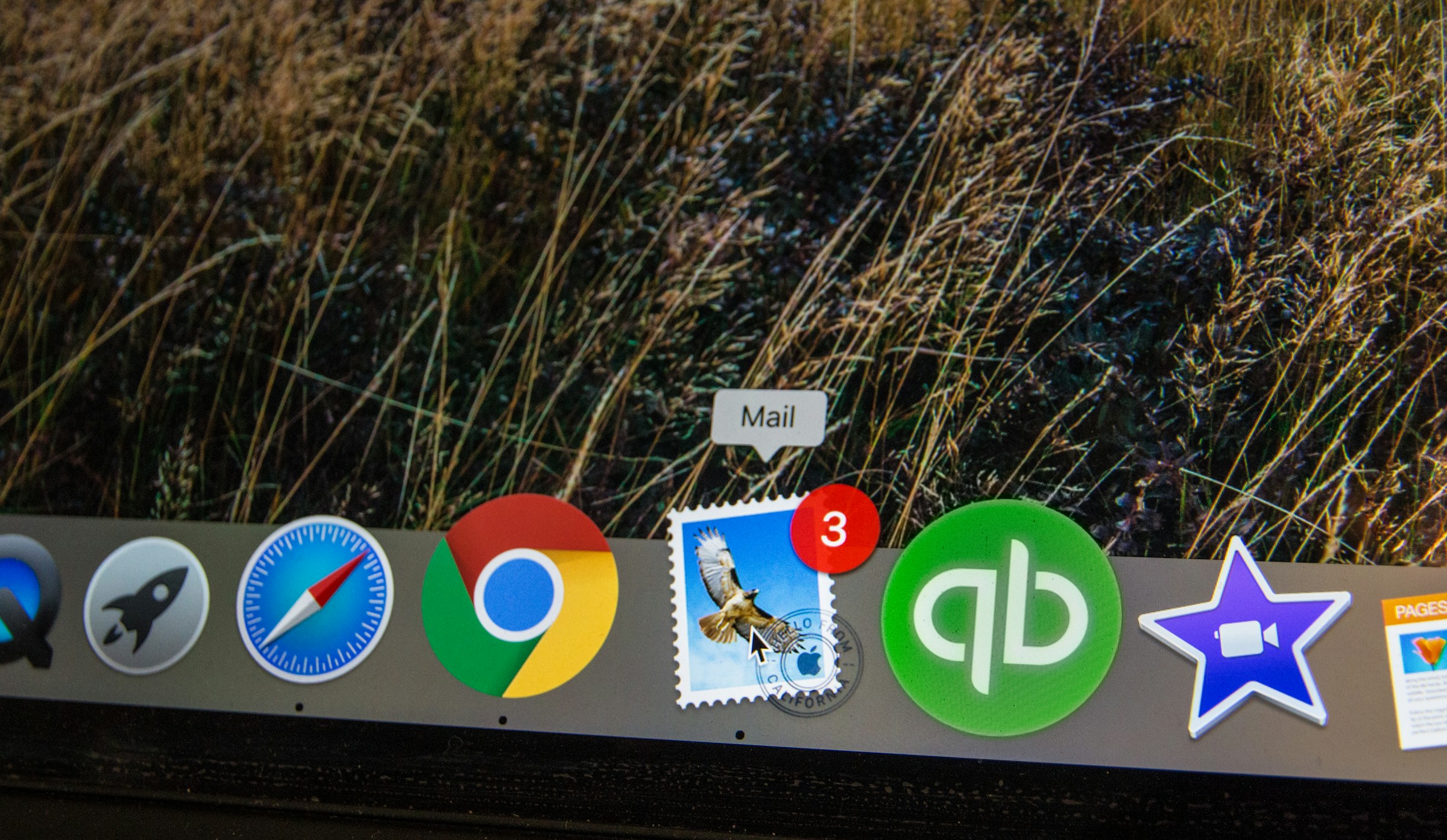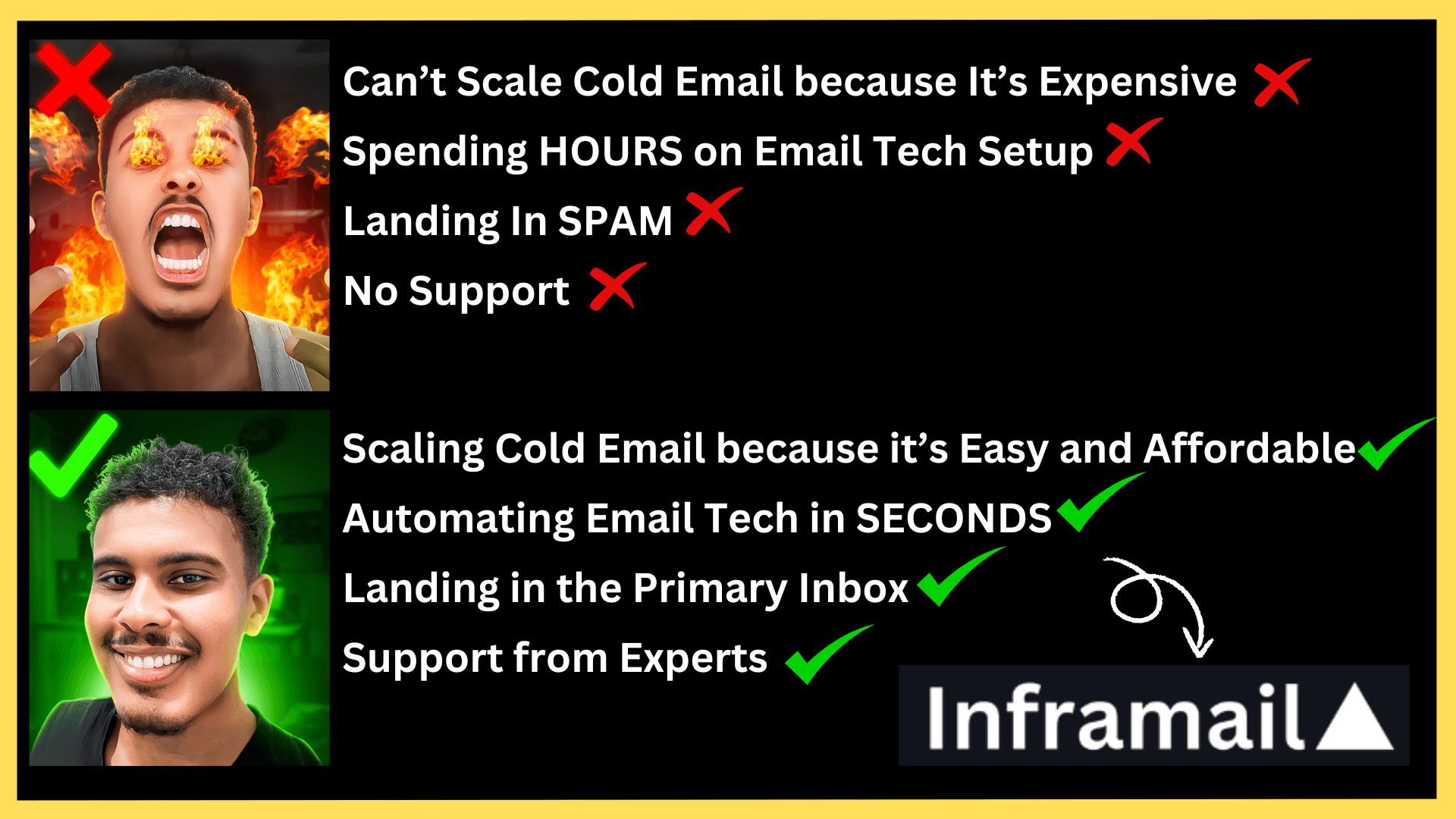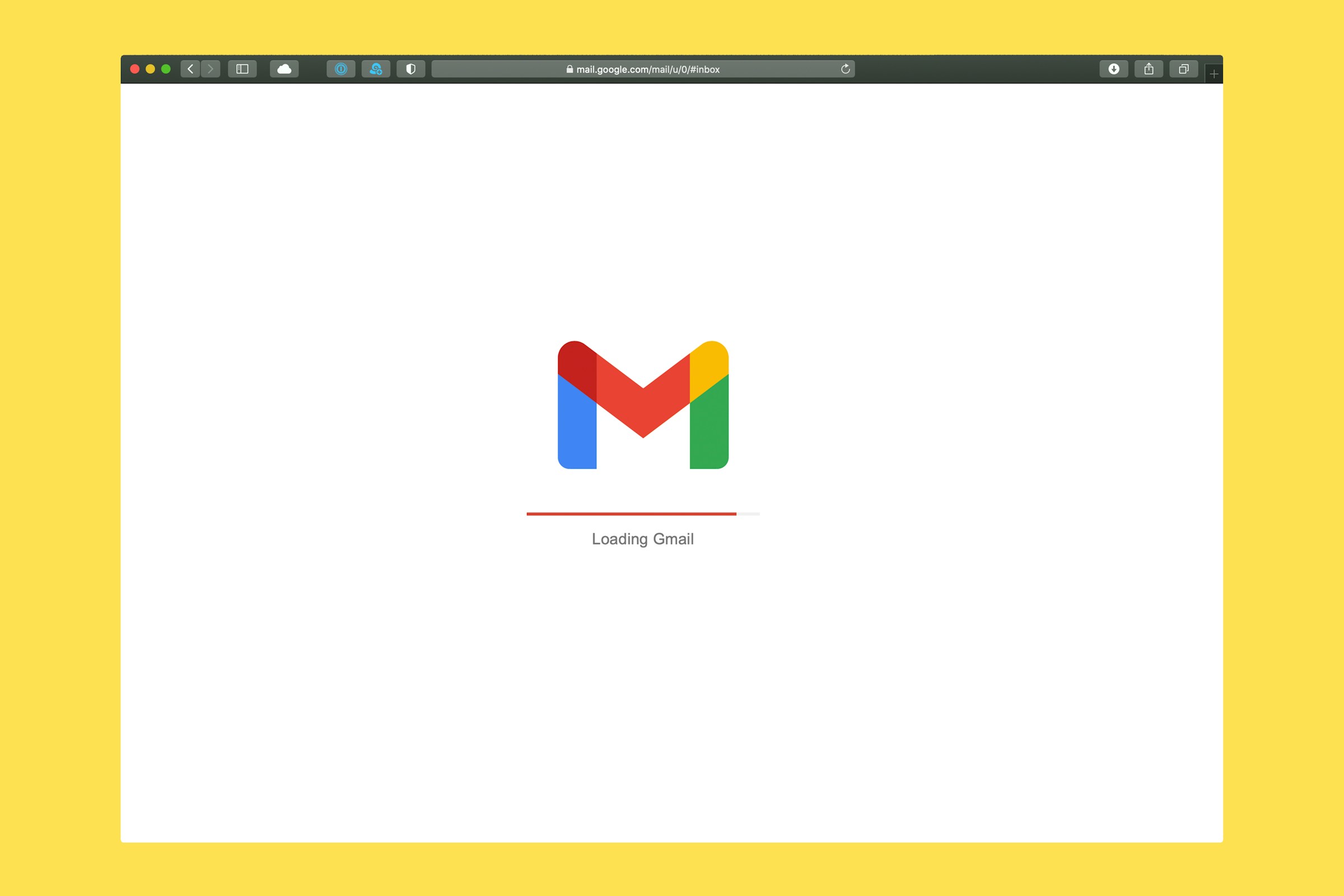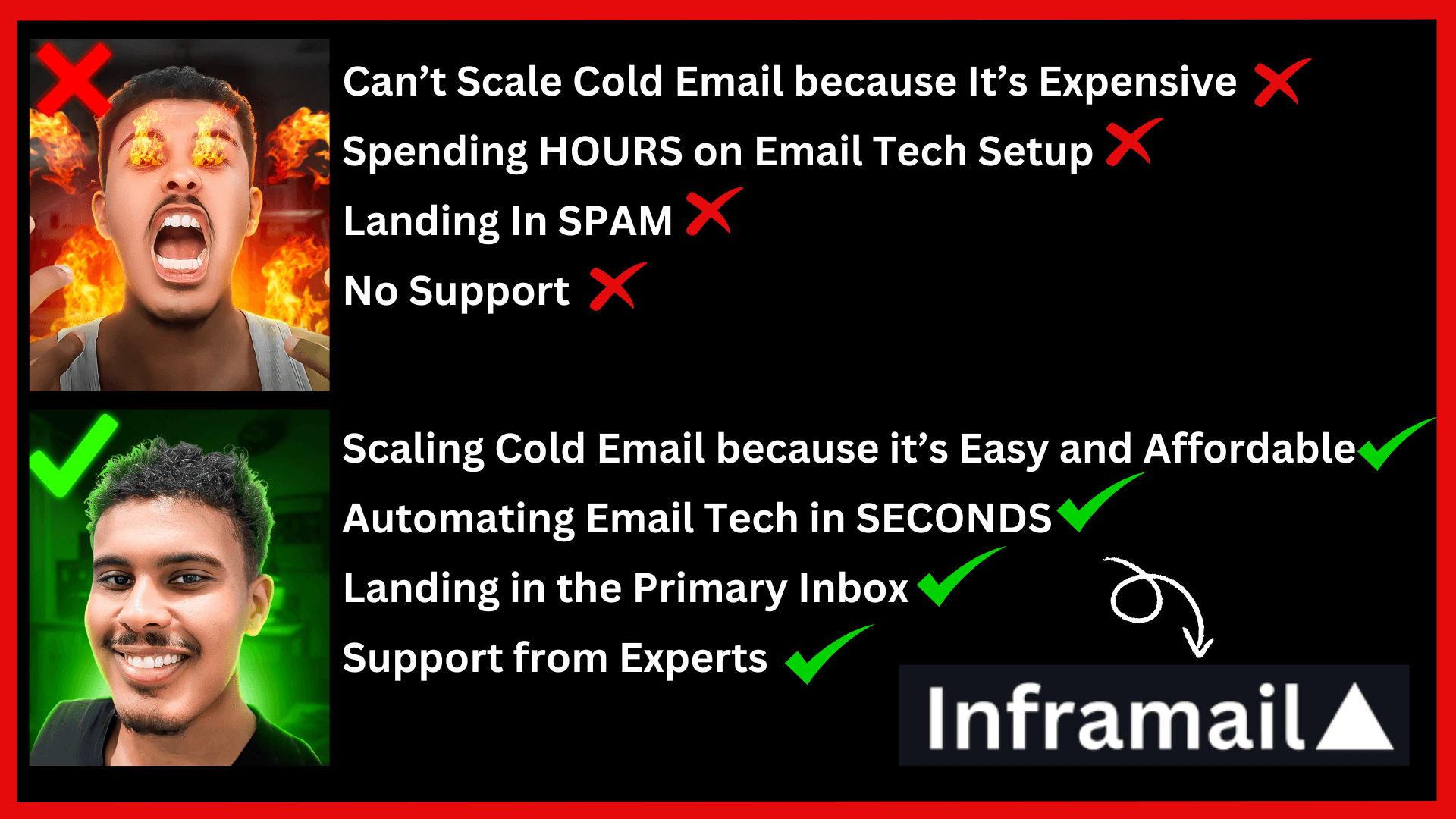Feb 28, 2025
What is a Cold Email?

A cold email aims to gain sales, opportunities, or any other dual benefit from someone with whom the sender has no prior relationship or connection. Cold emailing is a way to introduce yourself to someone you don’t know and try to build a relationship with them to eventually turn them into customers.
Here’s an example:
You have a software company that sells a powerful data analysis tool to enterprise-level businesses. Many companies could benefit from your software, but you need more resources to promote it. So, in such a situation, what do you do? How do you reach out to your prospects?
That’s where cold email comes in. It is an effective strategy for reaching new prospects and closing deals.
But many people need clarification on cold emailing and email marketing. Although both are powerful, their approaches and outcomes differ vastly.
What Is the Difference Between Cold Emails and Email Marketing?
No, cold email and email marketing aren’t the same. Both are different approaches to reaching potential customers or clients. The critical difference is in the relationship between the sender and the recipient.
Cold emailing involves sending highly personalized emails to people you have never connected with. The goal is to initiate the contact and establish a relationship so that you can pitch the product or service.
Many companies use cold emails for their sales outreach efforts. Some of the famous brands include:
HubSpot
HubSpot has a dedicated team for cold email outreach. They use personalized emails to introduce their software to potential clients. By offering free trials and demos, they’ve converted many prospects into paying customers.
Dropbox
Dropbox uses cold emails to reach potential users and offers them additional storage space if they sign up through a referral link. This has helped Dropbox rapidly expand its user base and become one of the most popular cloud storage providers.
Grammarly
To reach potential users, Grammarly offers free trials to businesses and enterprises. Cold emailing has generated leads and grown the company's user base.
Cold Emails vs. Email Marketing: Understanding the Key Differences and Best Use Cases
Here’s an example of a cold email:
Cold Email Template
Subject: Let’s talk {{First Name}}!
Hey there, {{First Name}} How are you doing today? I am {{Name}} and I work at {{company name}}.
We work with companies like {{their company name}} to: {{mention pain points and the solutions offered}}
I would like to know if you are the right person to talk with about this. I would love to contact you over the phone, as having an actual conversation could be beneficial.
If you are interested, reply to this email and let me know your availability.
Cheers, {{Your Name}}
In contrast, email marketing involves sending targeted emails to a list of subscribers who have opted to receive your emails. The goal is to build a relationship with the subscribers by providing them value regularly and ultimately converting them into customers.
Many businesses use email marketing for their inbound sales efforts; here are some of them:
Airbnb
Airbnb sends personalized and engaging emails to its subscribers, highlighting different travel destinations and experiences.
Kate Spade
The fashion brand sends promotional emails offering discounts and limited-time offers, encouraging subscribers to purchase.
Litmus
The email marketing company sends regular newsletters providing insights and tips on best practices for email marketing.
Key Metrics: Tracking Success in Cold Emails vs. Email Campaigns
Now that we have a basic understanding. Let us see in detail how cold emailing and email marketing are different from each other:
The goal
Cold emailing aims to make the initial contact and generate leads from potential customers. Email marketing aims to build relationships with:
Existing customers
Educate them about products or services
Keep them up-to-date on the latest offerings
Drive conversions and sales
Level of personalization
When cold emailing is discussed, the level of personalization is the highest, as it is done on a 1:1 basis. Personalization is less and may be spammy if not done correctly when discussing email marketing.
The frequency of emails
In cold emailing, the number of emails sent to a recipient initially is high, with multiple follow-up emails. Regarding email marketing, the number of emails sent depends on a case-to-case basis, typically 1-2 emails per week or month.
Metrics and KPIs
In cold emailing, the focus is on:
Email deliverability rates
Open rates
Response rates
Click-through rates
In contrast, email marketing focuses on:
Open rates
Click-through rates
Conversion rates
Revenue generated
Usage of tools
The tools used for cold emailing include:
Finding prospects
Building lists
Verifying email addresses
Email warmups
Scheduling
Follow-ups
The tools manage subscriptions, create email content, and analyze campaign performance in email marketing.
From the above, it is clear that cold emailing is a strategic approach to reaching potential customers. In comparison, email marketing involves sending promotional emails to existing customers. Unlike cold emailing, the recipients have given their permission to contact them.
Since we contact recipients without permission, is sending cold emails considered spam or illegal? Let's find out.
Are Cold Emails Legal?
Cold emails are generally considered legal, but their legality depends on the laws and regulations of the specific country or region.
For example, the CAN-SPAM Act in the United States requires precise email opt-out mechanisms and accurate information in commercial emails. Failure to comply can result in penalties. Cold emailing is 100% safe and legal as long as your outreach strategy complies with the relevant national and state spam laws. But it is essential to understand the regulations of the sender and the recipient’s country before sending the email. It should be evident that cold emailing is not spam and is considered legal. Let’s discover why it is so effective.
The Benefits of Cold Emailing
If you are trying to reach potential customers, cold emailing can be an effective strategy for your business. To automate the process, professional lead generation experts send cold emails through cold emailing software.
Here are some key benefits of cold emailing:
1. Targeted
Cold emailing allows you to target specific individuals or businesses that could benefit from your product or service. You can personalize your message for each recipient, increasing the chances of a response.
2. Scalable
Cold emailing is a scalable method of reaching potential customers or clients. You can send hundreds or even thousands of emails at once, reaching many potential clients quickly.
3. Cost Effective
Unlike traditional marketing and sales methods, you do not need to spend much on advertisements or referrals. All you need is an email address and a well-crafted message.
4. Better ROI
Cold emailing can provide a better return on investment (ROI) than other outreach methods. To determine the effectiveness of your campaign and make adjustments as needed, you can easily track your:
Open rates
Reply rates
Conversion
By now, you should understand the benefits and effectiveness of cold emailing. Let's explore its various use cases and how to maximize its effectiveness.
The Various Use Cases of Cold Email
There are multiple use cases for sending cold emails, and the actual use case may differ based on your requirements.
Here are some of the most common use cases of cold emailing:
Lead generation
An example can be, let’s say, you run a B2B software company, and you’re trying to generate leads for your product/service. You can research your target audience and prepare a list of prospects. Once you identify the needs of your prospects, you can craft a compelling message and pitch your services to them. This way, you can reach hundreds of thousands of prospects with targeted messages and generate unlimited leads. You start with building a relationship and slowly move towards converting them into valuable customers.
Example of a cold email for lead generation:
B2B Cold Email Template for Lead Generation
Subject: 10x your sales this quarter!
Hey there {{First Name}},
I have an idea that I would like to share that can help {{company name}} accelerate their sales this quarter.
I recently helped another of our clients {{SaaS company name}} almost quadruple their sales using this idea!
Let’s schedule a quick call sometime next week, {{First Name}}, so I can share this idea with you too. Which day and time works best for you?
Regards, {{Your Name}}
Business partnerships
Cold emailing can also be used to establish partnerships with other businesses. This involves reaching out to potential partners and explaining how your company can benefit theirs.
Let’s say you run a digital marketing agency specializing in social media management and want to partner with popular influencers in your client’s niche. You can start by researching influencers in your desired industry and creating a list of potential partners. Once done, you can email them a compelling offer, ultimately closing the deal. A well-written cold email can start a conversation that leads to a mutually beneficial partnership.
Here’s an example of a cold email for business partnerships:
Business Development Partnership
Subject: Something new for {{Company Name}}!
I am {{Your Name}}, the CEO and founder of {{Your company name}}, {{mention what you do}}.
I’ve been following your company's work for a few years, and I love {{mention something you love}}. I am emailing you because I believe the partnership between our two brands can help [[increase sales and build brand awareness to various target markets]].
Is this something you would be interested in? Please let me know if you want to discuss this further over the phone.
I am looking forward to hearing from you.
Thanks! {{Your Name}}
Networking
Cold emailing can expand your professional network. You can contact people you admire or who want to work in your industry or related fields.
For example, you want to network with others in your industry with whom you have just connected at a webinar or a seminar. You can start by:
Visiting their website
Finding their email addresses
Creating a list using a third-party tool
Once done, you can send them targeted and personalized emails and build connections. A personalized and thoughtful cold email can help you establish connections and potentially lead to future collaborations.
Here’s an example of a cold email for networking:
Networking Template
Subject: Breaking the ice, let’s get to know each other!
Hi there, {{First Name}}
I noticed both you and I are members of the [[LinkedIn Group - name of the group]]. They recently hosted a [[webinar]] on {{Topic}} and I saw you attending as well!
Looks like we’re both interested in {{Shared interest}}. What do you think of the latest {{Something new about shared interest}}?
I recently came across this [[video]] that I think you will like!
Anyway, I hope you had a chance to check my previous email(s).
Let’s talk!
Warm Regards, {{Your Name}}
Link building
You can use cold emailing to acquire links for your website. You need to identify websites relevant to your niche and then give them a personalized pitch about why they should link to your website or content.
For example, you are in the business of selling eco-friendly cleaning products. You recently published a blog post on the benefits of using natural cleaning products, and now you want to build links for that article.
To find potential link targets, search for related terms in your niche and identify a list of websites from which to get a link. Once done, you can start building a list of people who would best pitch for a link. By crafting a personalized, relevant pitch and reaching out to the right people, you can increase your chances of acquiring high-quality links that will help boost your SEO efforts.
Here’s an example of a cold email for link building:
The “Link Builder” Template
Subject: Impressed with your new blog!
Hey there {{First Name}},
I recently had the opportunity to read your {insert title} and thought it was exciting and intricately put together.
Hence, I suggest adding the link to {insert title of blog} to help your readers better understand the message you’re putting forth.
This can enhance your overall article piece by adding key information for your readers.
It will decrease your bounce rate and increase the average session time (and so many other metrics that we’re happy to discuss with you!).
We’re happy to add links from your blogs/website to our blogs, too.
Let me know if you are open to this collaboration.
Best, {{Your Name}}
Recruitment
You can also recruit potential employees by cold emailing. This involves reaching out to people who may be a good fit for a job opening at your company.
An example can be you are a hiring manager for a software company looking for senior engineers. As an HR, you have identified & created a list of a few qualified candidates, but they aren’t currently looking for a new job. To reach out to them, you can draft a personal cold email letting them know about my company and the position. You can also highlight how the candidate’s experience and skills match the role and how they can be a great fit for the position at your company. A well-written cold email can grab their attention and encourage them to apply.
Here’s an example of a cold email for recruitment:
Recruiting Email Template
Subject: Interested in joining {{company name}}?
Hello {{First Name}},
How are you doing today? I am sure you get many emails like this!
I recently saw your [[design]] published on {{platform}}, and it caught my attention!
I am part of the recruiting team at {{company name}}, and I am reaching out because we have a vacancy for {{job title}}. Given your skills and experience, I know you will be a great fit at {{company name}}.
Here is a link to the job description: {{link}}
I am also linking our company website: {{link}}
Are you interested in this? Let me know.
Thanks, {{Your Name}}
Mastering Cold Email Outreach: Planning, Personalization, and Execution

Now that we have seen the various uses of cold emailing, you might wonder if it involves just writing an email and hitting send or if there’s more to it. You should know that sending cold emails to prospects is a delicate art that requires careful planning and execution. This is what we call cold email outreach.
Related Reading
• Automated Lead Generation
• Email Prospecting
• How to Generate B2B Leads
• How to Warm Up Email Domain
• How Many Emails Can You Send Before Considered Spam
• Best Time to Send Cold Emails
• Best Cold Email Templates B2B
• Email Outreach Best Practices
• Email Outreach Strategy
The 4 Components of a Cold Email (& How to Nail Them)

1. Nail the Subject Line to Get Your Cold Email Read
Your subject line is one of the first things your potential client sees in their inbox, and it’s usually a deciding factor in whether or not they open your email. So, no pressure, right? You don’t need to spend hours developing the perfect subject line, but you should consider it. Make sure your email subject lines are:
Short: 60 characters or less so recipients will see the whole thing
Interesting: Try to provoke curiosity
Relevant: Make sure your subject line is an honest reflection of what’s in your email
Crafting High-Converting Email Subject Lines for Outreach and Engagement
Let’s say you’re offering to solve a client’s problem by providing a product or service. You could use any of these options:
Need help with [client pain point/problem]? I can help.
Example: Need help increasing your site’s traffic? I can help.Tired of [client pain point]? Let me help you.
Example: Tired of dates that lead nowhere? Let me help you.[Pain point] There’s a better way!
Example: Paid ads not converting? There’s a better (cheaper) way!
Or, if you’re trying to build a relationship with someone, you could write something like:
You’d love this [blog/article/video] about [topic relevant to them]
Example: You’d love this video about helicopter parenting
You could also ask them a question about a piece of content they recently posted:
Quick question about your [topic] [article, video, blog post]
Example: Quick question about your intuitive eating video
If you have a mutual contact, you can mention that in the subject line:
[Name of contact] recommended we connect
Using AI to Generate High-Performing Cold Email Subject Lines
There are tons of subject line ideas online, and you can also feed your email into ChatGPT and ask it to brainstorm subject lines for you.
Use this prompt: I’m sending this cold email to [name of contact] from [company]. My goal is to get him/her to [desired action]. Here’s the email body: [insert email body here]. Please generate 10 possible subject lines for this email. Make them under 60 characters, make them relevant to the email, and make them curiosity-provoking.
Personalize Your Greeting (aka the Opening of Your Cold Email)
This is the introduction to your email – usually the first 2-3 sentences. Ensure you’re addressing the email to an actual name (not a company name).
So: Dear [name], Or: Hi [name],
What you say next will depend on your goal for the email. Personalized greetings can look like this:
A genuine compliment on their product, service, or recent content: I resonated with your blog post about using customer testimonials in your marketing.
Empathizing with a pain point: As a former consultant, I understand how hard it is to get leads.
Name-dropping your mutual contact: Nancy Smith told me to reach out and connect with you.
Providing them with a resource: I’ve been reading your blog for over a year, and when I saw this video, I immediately thought of you.
Starting your email with a personalized greeting accomplishes two goals:
It shows them you’re a human and not a bot.
It shows them you care and didn’t just use a template and send a mass email.
Your Pitch (or Ask) Is the Next Part of Your Cold Email
Once you’ve greeted your prospect, it’s time to transition to your elevator pitch or other “ask”. Here, it’s best to get straight to the point. This could be where you copy/paste in your elevator pitch (see Step 3 above). Or, if you’re making a different type of ask:
Please introduce me to [contact name]. I could help him with [pain point].
I’d love your opinion on [specific topic or tool] when you can.
I have a quick question for you: [your question]
Your ask or pitch should be succinct – no need to elaborate or give a ton of detail. If the prospect is interested in engaging with you, you can give them more information later or in a discovery call.
Don’t Forget About the Call to Action (CTA)
What action do you want the prospect to take immediately after reading your email? At the end of your email, give them a friendly nudge to do it. This is called a call to action (CTA) in copywriting, and all of your emails should include one. CTAs could look like:
If you’re not too busy, hit “reply” and tell me your thoughts. I’d love to hear from you!
If you’re interested in my [service or product], reply to this email, and we can schedule a discovery call.
If you’d like to discuss how we can work together, here’s the link to my scheduler. Feel free to book a 30-minute call with me.
If you want to try [product], click this link for a free trial.
What Is the 30/30/50 Rule for Cold Emails?
The 30/30/50 rule is a strategic framework for crafting successful cold emails. It breaks down the components of an effective cold email into three categories:
Relevance
Personalization
Value
Each number represents a percentage of your email content that should adhere to these components: Relevance and personalization make up 30% of your cold email, while value makes up the remaining 50%. Applying the 30/30/50 rule creates a balanced cold email incorporates personal touch, pertinent information, and a strong nudge toward action. This balance can improve your response rates and help you reach your outreach goals.
Grab Attention with Relevance & Personalization
When you get a cold email, what’s the first thing you look at? The opening, right? The 30/30/50 rule breaks down the structure of successful cold emails into three categories, and the opening makes up 30% of your cold email. Picture the opening as the fresh, crisp lettuce and tomato on top of a burger – it’s what entices people. Your opening must hook your reader with relevance and personalization. Common mistakes include being too generic or not doing enough research about your recipient. Remember, the key is to make them feel like you’re reaching out to them specifically.
Provide Value To The Recipient
Another 30% is the body of your email. Think of this as the juicy patty, the substance of the burger. It contains the meaty details of your proposition. Your aim here is to provide value and explain why your recipient should care. Are you saving them time and money or providing a unique solution to a pressing problem? That’s what you need to bite into.
50% of Your Cold Email Should Include A Clear Call to Action
The final 50% is your call-to-action (CTA), the lower bun that holds everything together. The CTA must be:
Clear
Compelling
Easy to follow
It’s a mistake to leave this part ambiguous or to include multiple CTAs, as it confuses the recipient on how to proceed. Stick with one strong CTA for the best results.
Mastering the 30-30-50 Rule: Balancing Personalization, Value, and Action in Outreach
By appropriately applying the 30-30-50 rule, you balance personal touch with pertinent information and a strong nudge towards taking action. The more you practice and refine this technique, the better your results will be.
The Importance of Personalization in Cold Emails
When you’re reaching out with cold emails, picture yourself trying to start a conversation at a networking event. You wouldn’t use the same, generic line on everyone—you’d tailor your approach based on what you know about the person you’re speaking to. Personalization in cold emails works the same way; it’s about making the recipient feel like you’re talking just to them. You may think personalization means tossing the recipient’s name into the subject line and calling it a day. But there’s a common misconception: that’s not nearly enough. You’ve got to dig deeper.
Personalization vs. Overkill: Striking the Right Balance in Cold Outreach
Imagine you’re a detective looking for clues about what makes your recipient tick. Check out their respective information for hints about their interests or pain points:
LinkedIn profile
Company page
Recent tweets
Use this information to craft an opening that resonates personally. Here’s the thing, though—you want to avoid a common mistake: overdoing it. You’re not trying to be their best friend; you’re just showing that you’re paying attention.
Techniques for Personalization
Let’s talk techniques. Use a personalization tool to streamline your process, but always double-check for accuracy. Nothing breaks trust faster than getting someone’s details wrong. Here are some practical tips:
Mention a recent event or accomplishment they’ve shared.
Relate to an issue that’s prevalent in their industry.
Compliment a piece of content they’ve posted that genuinely impressed you.
Regarding methods, consider the difference between sending emails to a startup founder and a corporate executive. Your tone, references, and the value you offer must align with their world. Incorporating these personalized touches can be seen as following a map to hidden treasure. Your recipient is the X marking the spot, and your email is the series of well-thought-out steps designed to get their attention and lead them to take action. So, always aim to strike a balance. Be relatable yet professional, personal yet not overbearing. Your ultimate goal is to pave the way for a meaningful interaction that lays the foundations for a potential business relationship.
Crafting the Subject Line
When reaching out to potential leads, the subject line is your foot in the door. Think of it like a newspaper headline—it needs to be catchy but informative, giving your recipient a taste of what’s inside. Many folks get this step wrong by being either too generic or unintentionally misleading. So, how do you strike the right chord? Start with clarity and directness. You wouldn’t want your message lost in a sea of vague or spammy-looking emails. Personalization here is also your best friend. Referring to a recent event or a shared interest can jump-start engagement. For example, “Quick Question About Your Recent LinkedIn Post” is precise and suggests you’ve done your homework.
Crafting Engaging Subject Lines: Avoiding the ‘No-Reply’ Trap
Here’s what you need to avoid: the “no-reply” vibe. Subjects like “Monthly Newsletter” or “Exciting Offer” sound impersonal and are often ignored. Remember, you’re not a robot, and neither is your recipient. Instead, what if you tried stirring curiosity or suggesting urgency—without being pushy? “Missing Out on SEO Opportunities?” or “Your Quick Feedback Needed!” can nudge the reader into thinking there’s something beneficial inside for them. But tread lightly; balance is key to not seeming desperate.
Tailoring Subject Lines for Different Audiences: Strategies for Higher Engagement
Various techniques can serve different contexts. If you’re after a quick response, questions in the subject line work wonders. When you need to establish expertise, sharing little-known information can prompt a “tell me more” reaction. Consider segmenting your list to integrate this into your cold email strategy. Not all leads are created equal; your subject lines should reflect that. Use metrics from past campaigns to inform what resonates with specific demographics. Split testing different subject lines can also uncover what triggers your audience’s interest, allowing you to refine your approach with each send.
Subject Lines That Start Conversations: Personalization Beyond Clickbait
Tailoring subject lines to your leads' precise interests and pain points isn’t just smart—it's respectful. It shows you value their time and are not just another name in their inbox. Dedicating the extra effort to your subject lines lays the groundwork for a conversation, not just a conversion.
Writing the Email Body
After nailing your opening with a personalized touch, it's time to tackle the email body, a crucial section where you'll further engage your reader. This makes up about 30% of your content, where you pour value into your message. Imagine the body of your email as a friendly chat in a coffee shop. You wouldn’t jump straight to a hard sell. Instead, you'd build up the conversation, offering tidbits that spark interest and connection. Your email should do the same – it should balance informative content and conversational tone.
Avoiding Common Cold Email Mistakes: Clarity, Tone, and Relevance
Here are some common mistakes you'll want to avoid:
Overwhelming the recipient with information: It's like dumping a pile of brochures on someone's table. Too much, too fast. Break it down. What's the one thing they need to know right now?
Being too formal or too casual: Find the sweet spot. You're not talking to a robot or texting a friend about the weekend. Your mantra is professional yet approachable.
Lack of focus: If your email rambles without a clear point, it's like a bad date that won't end. Get to the point, and make sure it matters to them.
Personalized Email Messaging: Data vs. Storytelling for Maximum Impact
Regarding techniques and variations, think about the person on the other end. Do they strike you as someone who appreciates data? A crisp bullet point list with key benefits or results could go a long way:
Increased efficiency by 40%
Cost reduction of 25%
75% more leads in the first quarter
If your reader loves a good story, provide a mini case study proving your point. Share a success story relevant to their industry or a challenge they might be facing.
Incorporating relevant practices involves understanding the field and the needs of your recipient. If you’ve segmented your email list, you can tailor the body of your message to address specific demographics or industries. Use your knowledge and previous email metrics to craft messages that resonate individually.
How to Cold Email Like a Pro in 9 Steps

1. Define Your Cold Email Goals to Target Your Audience Effectively
Before writing cold emails, determine what you want to achieve and define your goals. Your target audience will depend on this. For example, are you:
Trying to book more meetings as a consultant?
Or do you want to reach out to prospects for link-building?
A clear objective will help you:
Write better cold email subject lines
Pick an excellent cold email template
Have clearer messaging
Get better results
2. Identify Your Cold Email Audience After Defining Your Goals
Once you know your goal, it’s time to identify your audience. This part is crucial because you must adequately research your target audience for your cold emails to drive results. Find out their pain point, what they read and consume, how they communicate, and what they expect.
For example, you’re an agency contacting prospects and asking for links in your cold emails. You’ll typically look in companies with great websites from which you can get a link for editors, like:
Heads of content
Webmasters
More senior marketing managers
The size of the target audience matters, too. It should be narrow enough when you pinpoint people whose needs you can realistically solve.
3. Write Cold Email Subject Lines That Grab Attention
Subject lines in emails are the breaking point for your target audience. Sixty-four percent of recipients decide whether to delete or open your cold email based on the subject line. Whether you want to reach out with your first cold email or do some follow-up, subject lines deserve special attention.
These two subject line examples are:
Book a free meeting to get more sales!
Hey, first name, get more conversions from paid traffic
They may seem similar from a distance, but the second subject line is bound to perform better. It’s personalized and attacks a pain point for a specific target audience. The general rules for writing a subject line apply, such as how long it should be and what characters (not) to include. The most crucial point with cold emailing is to make it short and personalized and attack a specific pain point.
4. Make Your Opening Memorable
You're off to a great start if someone opens your cold email based on the subject line. But still, it’s just a start, and you want to maintain that attention. According to Litmus, the average person spends about 9 seconds reading an email, so you want to capitalize on that.
If we take the example of a cold email from our previous step, this is how the intro would go:
Hey, first name. Is your paid traffic cost increasing, but you’re not getting a good return on ad spend? You’re not alone. Other industry experts say the same. But we have a playbook you need to see to get amazing ROAS again.
It’s short, reads well, and addresses the reader's pain point. Don’t use generic openers and complex greetings. Hit them head-on with something that will make them read through to the end.
5. Introduce Yourself and Who You Are
Now that your cold email interests you, you want to show some social proof. Why are you the right person to talk about this pain point of theirs? You don’t have much time and space to flaunt my awards and accomplishments, so keep it short and to the end. In the case of the cold email we started, this would be an excellent addition to the opening:
We’re a paid ads agency based in the area. We help brands like yours in the industry get more out of their paid campaigns. Our clients see a 40 percent increase in ROAS after working with us.
Many cold emails fall flat because the person sending them fails to introduce themselves properly in the email body. You don’t have the length of a blog post to present your achievements, so pick the most relevant one for the target audience. If you want to include more details, you can do that in the follow-up email.
6. Show That You Deeply Understand Their Pain Points
The essence of cold emailing once more is showing potential customers that you’ve dealt with the same problem and solved it before. Think about what keeps them up at night and where your business could help the most.
Pro tip: The typical cold email template does not include these details. You must research what would make your prospect grab their credit card.
In the case of our example, something like this would work:
We just worked with a client who spent $50,000 per month, and ROAS declined month over month. After just one strategy session, they improved their ROAS by 30 percent. We want to help you do the same.
This part of cold emails is the most difficult because you need prior experience with someone with that pain point to know how to frame your offer. So, before doing any cold emailing, ensure you have an excellent track record of solving problems for my existing customers.
7. Add Your Offer
If you’ve done everything right and piqued their interest with a catchy subject line and great social proof, you should be well on your way to their wallets and hearts. They know what you do from the beginning of your engaging cold email; now it is time to make an offer to do the same for them.
This may look like the cold email we’ve been writing in this article:
We’d like to analyze your current free paid ads strategy. We’ll sit down together for 30 minutes to find out why it’s not producing the results you want.
You don’t immediately have to get them to:
Purchase consulting services
A product
Something else
Getting them on a call is a massive win for your cold emailing efforts.
8. Finish Off With a Strong Call to Action
Every good cold email template ends with a solid call to action. It comprises just a few words explaining to the reader precisely what they need to do after reading the email.
In our example, it would be this:
Book your free call today, And that’s it.
Remember, the call to action should align with my offer in the previous step of your cold email. You don’t want to offer a free trial and have the CTA ask them to book a free demo.
Examples of good calls to action include:
Book a free demo
Grab your free trial
Start today for free
Talk to an expert
Download your ebook for free
Sign up for a free plan
9. Use Follow Up Emails to Improve Cold Email Results
As any cold emailing expert will tell you, there are more efficient strategies than just sending one cold email and hoping it sticks. Most people who send and write cold emails send at least three to four follow-up emails after their first message.
The good news? You can automate this work with good cold email software like Woodpecker.
The bad news? It takes time to understand how many times to follow up and at which intervals.
In general, follow-up cold emails are more accessible and shorter to write because you have already broken the ice with my initial message. And just like you can grab a cold email template, you can do the same with a follow-up email series, too.

Related Reading
• Best Cold Email Software
• How Long Should a Cold Email Be
• B2B Cold Email Response Rates
• How to Improve Email Deliverability
• Unlimited Email Hosting
• Email Testing Tools
• Best Email Deliverability Tools
• Sales Email Automation Tools
• Email Scraping Tools
• Best Sales Prospecting Tools
• Email Warm Up Tools
• Email Personalization Tools
• Mailscale Alternatives
• Mailforge Alternatives
4 Best Practices for Successful Cold Email Campaigns

1. Research Your Prospects Before Hitting Send: The More You Know, the Better
A generic, one-size-fits-all email is always likely to end up in the trash. Before hitting send, take the time to:
Understand your prospects
Business structure
Trends in their industry
Potential needs
It shows that you respect their time and am genuinely interested in building a relationship. So, how should you research? Always start with LinkedIn. Depending on the prospect, you can request a connection with them on that platform; it enhances the credibility of eventual cold email outreach and differentiates your communication from generic sales pitches.
You can also examine the prospects company website, especially their recent achievements. Use this info to create a highly personalized cold email. This will make your outreach efforts:
Stand out
Demonstrate that you understand their unique situation
Want to help them succeed further
2. Avoid Anything Generic: Personalization Is Key
Looking at my inbox right now, I can’t count the number of emails devoid of personality and with generic phrases like “favored customer.” I’ll probably let them gather virtual dust forever. If you prioritize personalization, your cold emails will only stand out to your target audience.
Focus on why you’re contacting this specific person. Maybe I’d have opened the email if the sender justified why they called me a “favored customer” compared to others — or if the email had said, "I read your email marketing post, and I’m a huge fan of your innovative approach to personalization strategies.” Specify how you came across the lead. It’s a simple step, but it shows you didn’t just grab their contact information from a vast email list without any thought.
3. Follow Up Strategically: First Emails Often Go Unanswered
It’s hard to admit, but sometimes, you can send excellent cold email content without a response. Most of the time, the first email goes unanswered. Therefore, always plan two or three thoughtful attempts over several days or weeks. If you don’t get a response after that, move on.
Sending too many messages annoys people. Stick to these etiquette rules when you send a follow-up email:
Timing is critical. Give the recipient enough time to read and consider your initial email without feeling rushed.
Be professional. Acknowledge the recipient might be busy and that you don’t take it personally if they haven’t had a chance to respond.
Add value. Throw in one more relevant article, insight, or offer that might interest the prospect.
Keep it brief. Reiterate the main point of your initial email and express my continued interest in building a relationship.
4. Respect the Recipient’s Privacy: Personalization Shouldn’t Be Creepy
While personalization is vital to cold emailing, avoid using so much personal information that it makes the recipient uncomfortable. Imagine opening an email that reads,
“Hi, I saw on your Facebook page that you’re back from a vacation to Hawaii. I bet you had a great time in the poolside suite. By the way, I wanted to reach out about ...”
It would make me uneasy, so avoid delving into the person's family life or personal activities. Instead, reference a professional accomplishment to show your genuine interest in their work.
Here's an example:
“I found your recent article on LinkedIn about sustainable business practices very insightful. I wanted to reach out because ...”
The balance between personalization and privacy ensures my message is relevant and engaging without making the prospect uncomfortable.

Related Reading
• Sendgrid Alternatives
• Amazon SES Alternatives
• Mailgun Alternatives
• Maildoso Alternatives
• Mailreef
• Cold Email Marketing Services
• Cold Email Services
• Lemlist vs Instantly
• Smartlead vs Instantly
Start Buying Domains Now and Setup Your Email Infrastructure Today
At Inframail, we are revolutionizing cold email infrastructure with unlimited inboxes at a flat rate.
We provide:
Microsoft-backed deliverability
Dedicated IP addresses
Automated technical setup
This helps customer outreach efforts efficiently like:
Agencies
Recruiters
SDRs
The main benefits of using our service:
Automated SPF, DKIM, and DMARC setup
Dedicated email servers for each user
16-hour priority support daily
Unlike traditional providers that charge per inbox and leave you wrestling with technical configurations, Inframail streamlines the entire process. We handle the complex infrastructure setup while you focus on reaching more prospects.
InfraMail provides the robust email infrastructure you need without the usual technical headaches and per-inbox costs, whether you're:
An agency looking to scale outreach
A recruiter connecting with candidates
An SDR driving sales
Start buying domains now and set up your email infrastructure today with our email infrastructure tool.


